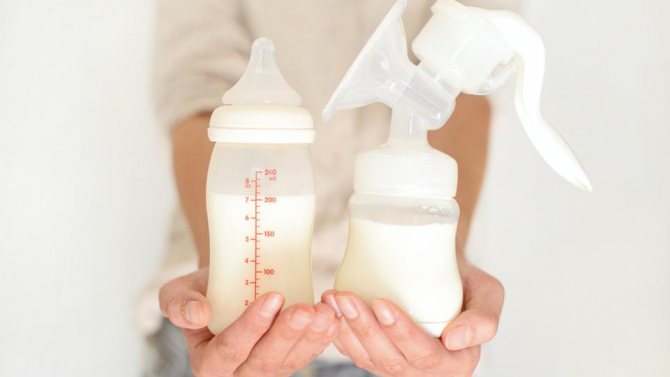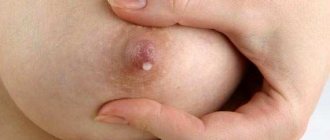The phrase “milk burnout” refers to a decrease in the production of breast milk up to the complete cessation of the lactation process. This phenomenon may be caused by natural reasons. The cessation of lactation can also be facilitated by conditions specially created by the woman, that is, artificial methods.
It is important for every woman who has given preference to breastfeeding to be very careful and scrupulous about the process of “milk burnout” and to study the features of this phenomenon in advance. Inattention to the completion of lactation and neglect of necessary conditions can cause serious consequences, for example, concomitant diseases such as mastitis and lactostasis. Therefore, a woman needs to know how long it takes for milk to burn out.
A thorough study of the phenomenon of “breast milk burnout”, as well as compliance with all the necessary rules and conditions, can make the process of completing lactation as simple as possible, painless and harmless to the health of the baby and mother.
Where did the expression about burnt milk come from?
If we take a closer look at the so-called term “milk burnout,” it becomes clear that this process has nothing to do with curtailing lactation. Ozhegov’s explanatory dictionary gives several interpretations of the verb “burn out”, which have no points of contact with women’s breast milk. Burn out - deteriorate from prolonged burning or strong heat, dry out from the heat or burn out.
It becomes clear that breast milk is not subject to such manipulations. However, these are precisely the sensations that the fair sex experience during the period of completion of lactation in an unnatural way: by ligating the mammary glands or by sharply limiting the number of times the baby is put to the mother’s breast.
Thus, it turns out that the term “breast milk burnout” does not exist as such, and it has nothing to do with the physiological processes occurring in a woman’s body and is incorrect. Typically, women use this phrase when breastfeeding ends and milk production decreases. The process of milk reduction is more correctly called “extinction of lactation.”
In what cases does breast milk burn out?
To maintain the production of the required amount of milk, you need to put the baby to the breast about 10 times a day. With each decrease, the tides become smaller. The burnout process occurs in three cases:
- Natural termination. After a woman realizes that her baby no longer needs milk, she gradually reduces breastfeeding, bringing it to zero.
The mother must remember that the end of lactation occurs smoothly; with a sudden refusal, lactostasis and mastitis develop.
There are cases of premature refusal of a baby to breastfeed. This is possible in infancy. So, with narrow ducts, the child cannot suck out the contents. It can also occur after the child is introduced to the common table.
- For certain diseases, the mother is required to take medications (antibiotics, hormones) that have a detrimental effect on the child’s body. She has nowhere to go, she must wean the baby faster. Stagnation in the duct will lead to spread, so you need to know how much breast milk burns.
When a virus or infection appears, the body temperature rises. If the indicators are critical, the body loses a lot of fluid, including milk. In such cases, it is useful to drink a lot of water. But sometimes this doesn't help. After the onset of the disease, the number of feedings cannot be reduced; the child will receive immunoglobulins through the mother’s mammary glands and will not become infected.
- When stressed, the level of oxytocin decreases, and the nutrient fluid in the gland ducts stagnates. The baby cannot suck it. Stress does not affect prolactin, so it does not directly reduce lactation. To maintain excretory function, you need to massage your breasts daily and latch onto your baby more often.
How does breast milk burn out? Process description

The so-called phenomenon of “breast milk burnout” occurs when the frequency of attachments of a small child to the mother’s breast is reduced to a minimum, and the amount of two hormones, prolactin and oxytocin, is significantly reduced. As a result, the excess is absorbed into the blood. This cycle continues until lactation completely stops.
As a result, part of the glandular tissue “falls asleep”, and the other part is absorbed by the female body. This phenomenon is called involution. The young mother’s breasts “return” to their previous parameters. It is worth considering that this process is quite slow and can take several months.
It is worth noting that there are several ways to help stop breast milk production:
- physiological;
- medicinal;
- traditional medicine recipes.
The safest method is the physiological method, due to the extinction of the sucking reflex. This phenomenon is observed in children over two years of age.
How and how long does breast milk burn out?
The main sign of breast milk burnout is a gradual decrease in its quantity. On average, its full production stops within 2-3 weeks. The extinction of lactation is influenced by several factors; among the reasons for the burnout of breast milk are:
- Intentional weaning of a child from the breast. Making such a decision must be balanced and justified. The process involves latching the baby to the breast more rarely, gradually decreasing to zero over time. Regardless of the timing of rapid or smooth weaning, the end result will be the same - the milk will disappear. Gradual weaning is less traumatic for mother and baby.
- Incorrect application sometimes causes milk to burn out. It is important to find the right, comfortable position for yourself and your baby. This will allow the baby to actively suck milk, completely emptying the breast. Incorrect attachment leads to a decrease in lactation and its gradual disappearance.
- Rare application provokes burnout of milk. This may be during a long separation from the baby or feeding according to a strict time schedule, and not at the request of the baby. If the separation is forced and further breastfeeding is planned, the mother will need to express herself.
Burnout involves the process where milk begins to be absorbed back into the blood. This happens until production stops. Initially, the amount of breast milk gradually decreases. The process is accompanied by some discomfort.
Symptoms and sensations

The process of so-called “breast milk burnout” is accompanied by the manifestation of certain symptoms. A woman experiences pain and heaviness in her chest. In addition, a young mother may experience an increase in temperature. A woman's mood often changes.
The beginning of the end of lactation is signaled by the general weakness of the female body and malaise. In addition, lumps of various sizes may appear in a woman’s mammary glands.
A nursing mother should pay maximum attention to her health. Very often, symptoms of cessation of lactation can be confused with signs of colds.
How to properly end lactation?
The process must be stopped by the age of 1.5 years. Sometimes this needs to be done earlier. Actions of a woman:
- Do not rush. Clean up one feeding at a time. You need to start in the daytime: lactation occurs more strongly at night. After morning porridge, do not breastfeed. Then stop feeding after lunch, dinner, and only then at night.
- Make sure that the child is ready for breastfeeding replacement. To do this, see how the baby reacts to formula or food. Timely weaning will prevent the development of dyspeptic disorders in the baby.
- It is important to devote a lot of time to your child. When breastfeeding, close physical contact occurs, which must be maintained further. This will give the newborn a feeling of security and comfort.
- Hormonal imbalance occurs when breastfeeding abruptly ends. The woman develops a depressed mood and loss of strength. This is a temporary phenomenon. Lasts 12 months.
How to properly end lactation. Recommendations

Completion of lactation will go well if several important recommendations are followed.
- In the first few days after weaning the baby, it is strongly recommended to place a pillow under the chest and stomach. This will significantly relieve pain, which in the first two days can be very strong and prevent a woman from sleeping peacefully and lying down.
- A cool or lukewarm shower, as well as cabbage leaf compresses, will help relieve pain.
- During the period of completion of lactation, a woman needs to wear the most convenient and comfortable underwear. Bras must be wire-free. They should be made of natural fabrics and equipped with wide straps that will provide the woman’s mammary glands with reliable support.
- You should pay more attention to the condition of your breasts and protect them from any damage.
- At the beginning of the baby's weaning period from breastfeeding, experts recommend reducing fluid intake. Since drinking plenty of fluids promotes active milk production. For the same reason, it is better to temporarily avoid hot foods that have a liquid consistency.

To prevent the milk from burning out, it is strictly not recommended to use the “grandmother’s method”, the so-called tightening of the breasts with bandages and various sheets. This will not only not bring the desired effect, but can also provoke the appearance of serious diseases such as mastitis and lactostasis.
Natural cessation of lactation
It is impossible to say exactly how many days later breast milk burns out if feeding is stopped deliberately. The hormones oxytocin and prolactin are responsible for lactation; their production is individual for each woman. Even when breastfeeding is stopped deliberately, gradually reducing the number of breastfeedings, in some cases hot flashes are felt for up to six months. Although when I try to express breast milk, the discharge is scanty - a few drops. If a woman abruptly weans her baby from the breast:
- the mammary glands become denser;
- general malaise is felt;
- pain appears in the chest area, sometimes radiating to the back.
The lymph nodes in the armpits may become enlarged and the temperature may rise. You need to prepare in advance for the termination of lactation as follows:
- Under no circumstances should you pump before or after feeding.
- Gradually wean your baby off the breast during the day. If you pay more attention to the child, “play up” his whims, take care of communicating with other children who already eat “adult” food, the withdrawal will be painless.
- It is advisable to change your daily routine. Changing conditions disrupts behavioral habits.
- The next stage is giving up morning feeding.
- The most difficult time to wean your baby off the breast is before bedtime. If milk production decreases and the mammary glands become soft, sucking will be difficult. Weaning will happen naturally.
- Increase the portion of dinner. A well-fed baby falls asleep easier.
It is impossible to accurately calculate how long it takes for milk to burn out after a baby is weaned. But this process is easy to speed up, even with a sudden cessation of lactation. You should express, but only until relief, and not completely. Reduce the amount of liquid you drink. Wear a tight and comfortable bra without tightening your breasts. Decoctions of sage or mint will help solve the problem faster. Before using medications to stop milk production, you should consult your doctor. The action of the drugs is aimed at changing hormonal levels and stopping the production of prolactin. Taking medications often causes side effects: sudden changes in blood pressure, dizziness and nausea, and sometimes blurred vision.
Should you see a doctor?
The optimal option for completing lactation is the physiological method, which is due to a significant reduction in the attachment of a small child to the mother's breast. Many mothers are interested in whether there is a need to contact a health care facility. If a woman wants her breast milk to burn out and lactation to stop, she must contact a medical institution for consultation with a qualified gynecologist.
The doctor will give practical advice, select the most optimal option for unnatural termination of breastfeeding, and write a prescription for purchasing the necessary medications. Contacting a specialist will allow a woman to complete breastfeeding as safely as possible, as well as avoid possible health problems.
When does breast milk burn out?
Even during pregnancy, every expectant mother is told stories about how important it is to preserve milk and what to do so that it does not burn out. The term “milk burnt out” dates back to the times of medieval Rus', as the result of completing breastfeeding was called. In those distant centuries, a woman who interrupted lactation due to the death of a baby or her own illness was at great risk, since the likelihood of developing infectious mastitis was high. Such a serious inflammatory process much more often led to sad consequences than in the modern world. Therefore, there was a ritual designed to help the milk leave without problems.
A woman squeezed a drop of breast milk onto a hot stove. People believed that the liquid would leave the breast as easily as it instantly evaporated from the surface of the stove, and they said that the milk was burnt, burnt out. In the modern world, this term means:
- end of lactation;
- termination of breastfeeding due to maternal illness (for example, complicated infectious mastitis);
- inhibition of lactation as a result of a stressful situation.
The question of the amount of time during which milk production in the female body stops does not have a clear answer. Since lactation as a physiological process occurs individually, its completion also has strictly individual timing.
On average, the breasts stop filling and minor discomfort disappears within a week after the baby is last put to the breast. If there is a lot of milk, and the woman chooses to express herself until there is slight relief, then the flow of milk stops after 3–5 days. For 1–2 months, you should control your diet and not overuse foods that promote lactation, in particular fermented milk.
If lactation was stopped abruptly, this will be accompanied by quite severe pain, breast engorgement, a feeling of heaviness and lumps in the glands. The breasts stop filling up within about two weeks. After taking medications, some women lose milk immediately after completing the course - from 2 to 14 days.
It should be noted that the release of small amounts of milk when pressing on the nipple or while taking a shower is observed for several weeks, months and even up to 6 years after breastfeeding.
This is absolutely normal. Additional manifestations of discharge may be a reason to consult a doctor:
- cycle disorders;
- discharge from the breast undergoes changes (color, smell).
Based on the study of “mother’s” forums, I saw some unusual ways to end lactation with clearly indicated timing of milk burnout. So, the milk was lost within a week, when the woman actively leaned on salty foods (cucumbers, fish). Breast ligation is also regarded as a very effective way to stop lactation: one woman lost her milk in two days. The most original method with the exact timing of the disappearance of milk was this: a woman came to the village grandmother in the morning and evening for three days. The old woman performed certain actions on her, and the milk was gone exactly three days later, to the last drop. However, I categorically do not recommend experimenting with your body; it is best to gradually reduce the number of feedings - in cases where there is time for this and health allows.
I have two kids, so I have faced weaning twice. With my eldest son, the weaning was gradual and it ended the moment I found out that I was expecting my second baby. At that time, my son was one year and 4 months old. The milk was gone within two weeks. And two months ago I finished feeding my youngest when he was one and a half years old. Milk is still being released drop by drop. Therefore, even for one mother, the two lactation processes may differ from each other.
Natural methods for ending breastfeeding

The safest way to end lactation is physiological, or the so-called feeding reduction method. First you need to reduce one feeding, then the second. As soon as the baby starts to get used to it, you need to remove another one. Between meals, you need to express milk from each breast, leaving a small amount in the mammary glands.
Then you need to eliminate night feedings. Gradually, milk arrives in smaller quantities, and the process of arrival itself occurs less and less often.
A nursing mother should avoid severe breast swelling, which can cause severe pain.
Artificial ways to stop lactation

Many women are interested in what needs to be done to make breast milk burn out. You can complete lactation at home. Especially when you consider the number of drugs that can be purchased at the pharmacy. But it is worth understanding that this method is justified only if there is a need to stop breastfeeding for medical reasons. In addition, every woman should remember that after taking such drugs it will be impossible to restore lactation. Many breastfeeding women prefer steroid hormonal drugs. Non-steroidal hormonal drugs are used to unnaturally end lactation.
That is why a large percentage of young mothers turn to traditional medicine so that the milk in the breast burns out.
In any case, before giving preference to one method or another, you should consult a specialist.
Is it possible to reduce the amount of regurgitation?
Everyone is convinced that regurgitation in babies who are gaining weight well is a physiological norm (that is, it will not cause danger). True, not everyone will like the fact that everything starts to smell like burp.

A frequently asked question in pediatricians' offices is: “Is there a solution to the problem of spitting up?” Doctors respond to this that everything will pass over time, you just have to wait. Babies stop unintentionally regurgitating stomach contents when they begin to sit up on their own, which is around 6-7 months. But what should moms and dads who can’t wait do? Pharmacies do not sell medications or special devices that will help solve the problem. The only thing you can use are remedies for excess gas formation. Some are made on the basis of simethicone (Sab Simplex, Espumisan, etc.), while others are made from fennel fruit (Plantex). You can also use dill water, known in Soviet times, or brew dill mixture at home. You just need to know the recipe. Regardless of what you choose, the medicine will remove gases from the tummy, which means that the pressure on the walls of the stomach will decrease, and the volume of regurgitation should become less.
Lactostasis
This pathological condition is accompanied by swelling and a feeling of heaviness that appears in the woman’s mammary glands. Lactostasis occurs as a result of stagnation of breast milk. This condition may be accompanied by an increase in body temperature, as well as fever, and the appearance of redness in the mammary glands.
To alleviate her condition, a woman needs to take a warm shower and drink hot tea. This will improve milk flow. Expressing will help relieve pain. After which you need to attach the baby to the sore breast.
Mastitis
Mastitis is an inflammatory process, which is most often a complication of lactostasis. This pathological phenomenon is characterized by a number of symptoms:
- increased body temperature;
- deterioration of general health, weakness, irritability;
- pain in the affected part of the chest.
If you suspect the presence of mastitis, you must immediately contact a medical institution to receive qualified assistance from a gynecologist. If necessary, the doctor can prescribe an ultrasound of the mammary glands, based on the results of which the doctor will confirm the diagnosis and tell you about the further actions of the young mother.











